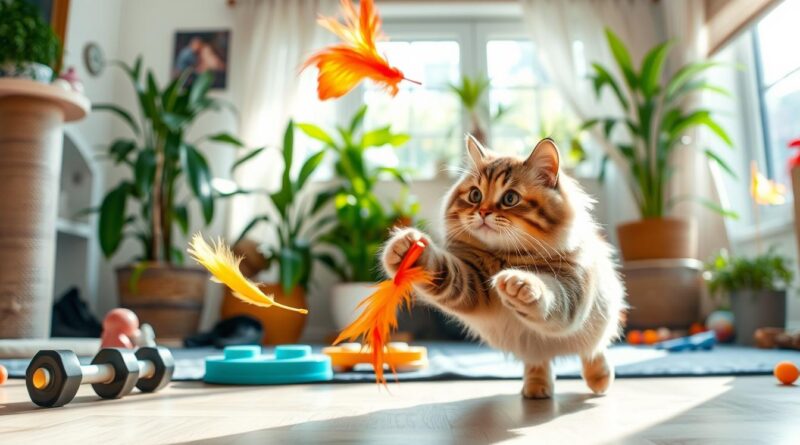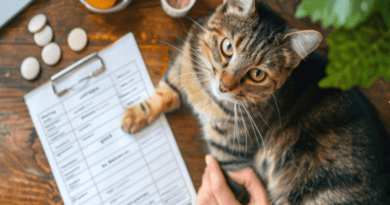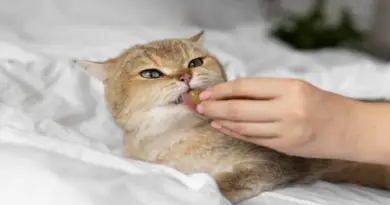Tips for Feline Fitness
Being a cat parent is incredibly rewarding, but noticing a feline’s waistline expand can be concerning. I knew immediate action was necessary to maintain my cat’s health and happiness.
Keeping a cat at a healthy weight can be challenging, but the benefits are immense. Each effort contributes to their overall well-being.
In this article, we’ll explore the risks of feline obesity, how to identify a cat with excess fat, and provide effective weight management tips. Whether your cat enjoys lounging or staying active, these tips will help keep them fit and energized.
Let’s work together to make sure our cats are happy and healthy. It’s time to focus on their well-being.
Key Takeaways
- Maintaining a healthy weight is crucial for cats to avoid serious health issues.
- Recognizing the signs of obesity in your feline friend is the first step to addressing the problem.
- Tailoring your cat’s diet and incorporating regular exercise can help them achieve and maintain an optimal weight.
- Understanding the underlying causes of weight gain can guide your approach to pet weight management.
- Regularly monitoring your cat’s progress and celebrating their milestones can keep them motivated and healthy.
Understanding Cat Fat: The Risks of Feline Obesity
Too much fat in cats can be very harmful. Obesity in cats is becoming more common. It can cause serious health problems that affect their life quality. It’s important to know the health risks of feline obesity to keep your cat healthy and happy.
Health Complications of Higher weight Cats
Higher weight cats face many health risks. These include diabetes, joint problems, and breathing issues. Excess fat can strain their bodies, causing arthritis, mobility problems, and heart disease. Also, feline obesity increases the risk of some cancers.
Identifying Signs of Obesity in Your Feline Friend
- Difficulty in breathing or labored breathing
- Reluctance to engage in physical activity or exercise
- Excessive grooming or licking of the paws and belly
- Visible accumulation of fat around the abdomen, neck, and hind legs
- Difficulty jumping or climbing
If you see these signs in your cat, see a vet right away. Early action can prevent serious health issues. Managing feline obesity is key.
“Obesity is one of the most common nutritional disorders seen in cats today. It’s important to be vigilant and take steps to ensure your feline friend maintains a healthy weight.”
Tailoring Cat Nutrition for Optimal Weight
Keeping your cat at a healthy weight starts with a balanced diet. You need to understand their nutritional needs and control portions. This helps support their weight goals and overall health.
Caloric intake is crucial for cat weight management. Cats need a certain number of calories based on their age, activity level, and more. Work with your vet to find the right caloric intake for your cat. Also, pay attention to how much you feed them.
- Choose a high-quality, cat-specific food that provides the necessary nutrients and balanced macronutrients.
- Measure food portions carefully to ensure your cat is not consuming excessive calories.
- Incorporate healthy treats and snacks, such as lean proteins or low-calorie vegetables, to supplement their diet.
Think about your cat’s feeding schedule and environment too. Feeding them small meals all day can help control calories. Also, a calm mealtime routine can improve their well-being and weight management.
“Proper cat nutrition is essential for maintaining a healthy weight and supporting your cat’s overall health and longevity.”
By adjusting your cat’s diet and feeding habits, you can help them reach and keep their ideal weight. Always consult with your vet to make sure their diet is balanced and effective.
Incorporating Exercise into Your Cat’s Routine
Keeping your cat at a healthy weight is key for their happiness. A good diet is important, but exercise is just as crucial. Let’s look at how you can add exercise to your cat’s day, whether indoors or outdoors.
Low-Impact Activities for Indoor Cats
Indoor cats can stay active with fun exercises. Try setting up a cat tower or scratching post for climbing. Hide treats or toys filled with catnip to encourage hunting.
Play with a wand or laser pointer for a great workout. It keeps your cat moving and happy.
Outdoor Enrichment for Active Playtime
Outdoor cats need a safe place to play. Consider a cat-proof enclosure or leash training. Add enrichment items like plants, scratching logs, and water dishes.
Outdoor play keeps your cat active and happy. It also lets them explore and hunt naturally.
Finding exercises your cat loves is key. Add them to their daily routine. This helps your cat stay healthy and happy.
Addressing Underlying Causes of Weight Gain
When dealing with feline cat weight loss, it’s crucial to understand that excess weight can sometimes be linked to underlying medical conditions or behavioral factors. By identifying and addressing these potential causes, you can better support your cat’s journey to optimal health and fitness.
Some common underlying issues that may contribute to weight gain in cats include:
- Hormonal imbalances, such as hypothyroidism or Cushing’s disease
- Chronic pain or arthritis, which can reduce a cat’s activity level
- Psychological factors, like stress or anxiety, which can lead to overeating
- Metabolic disorders, which can affect a cat’s ability to regulate their weight
If you suspect any of these underlying issues, it’s important to consult with your veterinarian. They can perform the necessary tests and examinations to diagnose the problem and develop a tailored treatment plan. This may involve medication, dietary adjustments, or physical therapy to address the root cause and help your cat achieve a healthy weight.
“Identifying and addressing the underlying causes of cat weight loss is crucial for the long-term success of your feline’s weight management journey.”
By working closely with your veterinarian and being attentive to your cat’s overall health and behavior, you can uncover and address the factors that may be contributing to their weight gain. This holistic approach will set your cat up for sustainable cat weight loss and improved well-being.
Monitoring Progress and Celebrating Milestones
It’s important to watch your cat’s weight loss closely. This ensures they stay healthy and keep losing weight. Celebrating their successes also keeps them motivated to stay on track.
Tracking Your Cat’s Weight Loss Journey
Set a regular time to weigh your cat. Use the same scale and record the weight each week. This helps you see if they’re losing weight at a good pace.
Also, notice how your cat looks and acts. Do they seem more active or have a slimmer waist? These signs show they’re doing well.
Remember, losing weight slowly is best for your cat. Don’t worry if it takes time. Celebrate every small win.
Rewarding Your Feline Friend’s Hard Work
- Give them healthy, low-calorie treats as rewards.
- Play their favorite games, like chasing toys or solving puzzles.
- Try a special grooming session or a new scratching post.
Watching your cat’s weight and celebrating their wins keeps them motivated. Together, you and your cat can reach a healthier, happier life.
Conclusion
Keeping your cat at a healthy weight is key for their happiness and health. Knowing the dangers of cat fat and feline obesity helps you act early. A balanced diet, regular exercise, and solving health issues can keep your cat fit and healthy for a long time.
Every cat is different, so it’s important to work with your vet to create a plan just for them. With hard work and sticking to the plan, you can help your cat stay at a healthy weight. This reduces health risks and makes their life better.
Looking after your cat’s health is a team effort. By focusing on their fitness and giving them the care they need, you can make sure they live a happy life.
FAQ
What are the health risks of feline obesity?
Obesity in cats can cause serious health problems. These include diabetes, joint issues, breathing troubles, and a higher risk of cancer.
How can I tell if my cat is fat ?
Look for a rounded belly, trouble grooming, and less activity. Check their ribs and look for a waistline to see if they’re fat.
What are the best ways to help my cat lose weight?
Start with a balanced diet and portion control. Add regular exercise. Work with your vet to find the right food and activities for your cat.
Can underlying medical conditions cause weight gain in cats?
Yes, conditions like hypothyroidism or Cushing’s disease can lead to weight gain. If your cat can’t lose weight, see your vet to check for health issues.
How can I keep my cat motivated during their weight loss journey?
Track your cat’s progress and celebrate their wins. Use healthy treats and playtime as rewards. Adjust their diet and exercise with your vet’s help.




